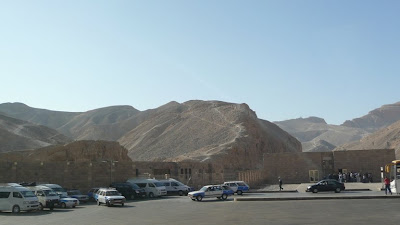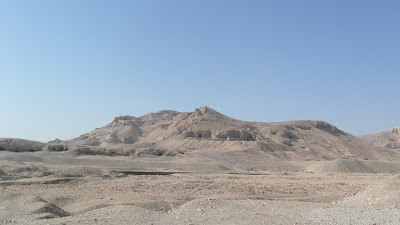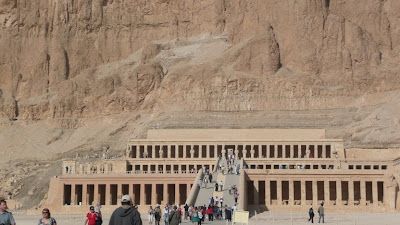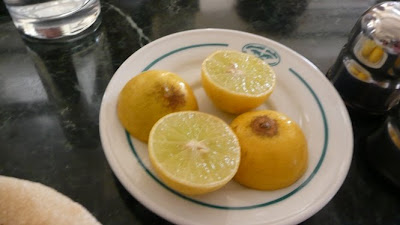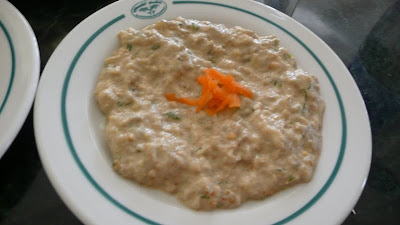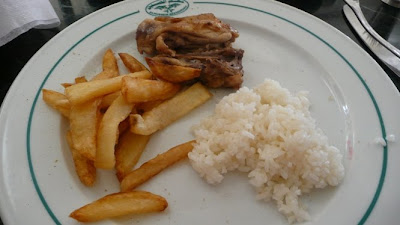At 5am we were up! First stop, the Valley of the Kings!!!
The Valley of the Kings (Arabic: وادي الملوك Wādī al-Mulūk, less often وادي بيبان الملوك Wādī Bībān al-Mulūk; “Valley of the Gates of the Kings”)[1] is a valley in Egypt where, for a period of nearly 500 years from the 16th to 11th century BC, tombs were constructed for the kings and powerful nobles of the New Kingdom (the Eighteenth to the Twentieth Dynasties of Ancient Egypt).[2][3] The valley stands on the west bank of the Nile, opposite Thebes (modern Luxor), within the heart of the Theban Necropolis.[4] The wadi consists of two valleys, East Valley (where the majority of the royal tombs situated) and West Valley.
With the 2006 discovery of a new chamber (KV63), and the 2008 discovery of 2 further tomb entrances,[5] the valley is known to contain 63 tombs and chambers (ranging in size from a simple pit to a complex tomb with over 120 chambers),[6] and was the principal burial place of the major royal figures of the Egyptian New Kingdom, together with those of a number of privileged nobles. The royal tombs are decorated with scenes from Egyptian mythology and give clues to the beliefs and funerary rituals of the period. All of the tombs seem to have been opened and robbed in antiquity, but they still give an idea of the opulence and power of the rulers of this time.
The area has been a focus of concentrated archaeological and egyptological exploration since the end of the eighteenth century, and its tombs and burials continue to stimulate research and interest. In modern times the valley has become famous for the discovery of the tomb of Tutankhamun (with its rumours of the Curse of the Pharaohs[7]), and is one of the most famous archaeological sites in the world. In 1979, it became a World Heritage Site, along with the rest of the Theban Necropolis.[8] Exploration, excavation and conservation continues in the valley, and a new tourist centre has recently been opened.
(Wikipedia.org)
No cameras and no video recording devices of any kind. You can see the natural formation of a pyramid in the mountains at the background. There lies the many tombs of ancient Pharaohs.
At any given time, you can only visit 3 tombs (they alternate the openings of the tombs to visitors) + the tomb of King Tutankhamun (LE100).
We managed to visit the tombs of Ramses I, Amenhotep II and Ramses III.
Somehow the valley wasn’t quite what I had expected, as I was hoping for more grandeur.
I was disappointed that the tomb of Ramses II wasn’t open to us today!! Drats!
From the valley, we journeyed on to the Temple of Queen Hatshepsut.
She is generally regarded by Egyptologists as one of the most successful pharaohs, reigning longer than any other woman of an indigenous Egyptian dynasty.
Deir el-Bahri (Arabic الدير البحري ad-dayr al-baḥrī, literally meaning, “The Northern Monastery”) is a complex of mortuary temples and tombs located on the west bank of the Nile, opposite the city of Luxor, Egypt.
From afar, the temple looked really beautiful, with its 3 terraces easily seen. Up close, the disfigurements and abuse of the structure was extremely depressing.
In 1997, 58 tourists and four Egyptians were massacred there by Islamist terrorists from Al-Gama’a al-Islamiyya in what has been called the Luxor massacre, causing a reduction of tourism in the area.
The first monument built at the site was the mortuary temple of Mentuhotep II of the Eleventh dynasty.
During the Eighteenth dynasty, Amenhotep I and Hatshepsut also built extensively at the site.
The location of the original temple of Mentuhotep II.
Trying to emanate the Queen/King (identity crisis Pharaoh), or as Farag calls her, “Hot Chicken Soup”.
The temple was attacked 3 times in it’s long history. Firstly, by Hatshepsut’s stepson (it’s a confusing lineage), Thutmose III, then by his son Amenhotep II and finally by the early fanatic Christians.
It is still possible to make out some brief scenes in the chapel dedicated to Anubis (the God of Mummification).
Within the inner structure of the main Temple.
Hello from above!
The columns and pillars within the chapel dedicated to the Goddess Hathor.
The original location of where the boulevard and gardens would have been.
From this temple, we made a brief visit to one of the many Alabaster factories (tourist stops) in the area, and on the way, we drove past the Ramesseum, the funeral temple of the great Ramses II.
A statue standing in the middle of the desert, forgotton amongst the ruins.
We next visited the Colossi of Memnon. The twin statues depict Amenhotep III (fl. 14th century BC) in a seated position, his hands resting on his knees and his gaze facing eastwards (actually SSE in modern bearings) towards the river. Two shorter figures are carved into the front throne alongside his legs: these are his wife Tiy and mother Mutemwiya. The side panels depict the Nile god Hapy.
Onwards to LUNCH!!
We were taken to El Hussein Restaurant in the Karnak region of Luxor for lunch. I’ve been googling, and can’t seem to find the exact address of this place. Apparently, there is more than 1 El Hussein Restaurant!
The food was average, and extremely minimal.
We had all preordered before we arrived at the restaurant… the choices were Fish, Chicken or Beef, and we couldn’t wait to be served.
Bread to go with everything…
Typical Egyptian soup… tasteless… unfortunately…
A plate of lemons…
Babaganoush…slurp!
This was an interesting pickled lemon chilli dish which was hardly touched by anyone. It had a very bitter taste due to the lemon rind…
Hommus…
A plate of fresh purple cabbage, which I squeezed lemon juice on…
A plate of spaghetti… (they seem to like pasta here)…
And the teeny tiny portion of my chicken!!! You bet there were complaints all round after the meal was done…
And dessert… extremely sweet, I hardly touched mine…
Overall Food Rating: 5.5/10
Restaurant ambiance: 6/10

